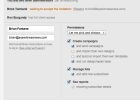Complying with CAN-SPAM Laws
The CAN-SPAM (Controlling the Assault of Non-Solicited Pornography and Marketing) Act of 2003 is an important legal issue for all US based senders of commercial email.
While certain aspects of the law still remain a little cloudy, there are some simple steps you can follow with AIMS to ensure you’re on the right track.
To make things easy, we’ve compiled a quick checklist for our US customers that you should try and follow to lessen the likelihood of unknowingly violating any of the sometimes ambiguous CAN-SPAM laws.
Managing Subscribers
- Use double opt-in subscriber lists To ensure you have the express permission of each of your recipients, you should use our double opt-in process when capturing new subscribers from your web site. When someone subscribes to a list you have set up, they will be sent an email with a confirmation link. When clicked, the subscriber will be added to the list, ensuring they have given you affirmative consent to hear from you.Don’t worry. You can customize this entire process, including the contents of the confirmation email and all landing pages so it’s as painless as possible for each registrant and consistent with the design of your web site.
- Process all unsubscribe requests within one week This won’t apply if you use our single-click unsubscribe method, because it’s immediate and 100% automated. If however you process your unsubscribes manually, you should ensure that an unsubscriber is removed from your list within 7 days of the request being made.
Sending Campaigns
- Use a legitimate from name and from email address The From Name and From Email address you specify in Step 1 of the Create/Send process must be a legitimate company or staff member name and the email address must be valid.
- Use accurate and descriptive subject headings The CAN-SPAM act means you can’t use subject lines that mislead your recipients about the subject matter of your campaign. This doesn’t mean you have to describe the entire contents of the email, but you should ensure that it somehow relates to some of the content within your campaign.
- Use a valid reply-to address that can function as an unsubscribe mechanism if required The law states that your campaign should either have a return-to address through which someone can unsubscribe or another “Internet-based mechanism, clearly and conspicuously displayedâ€.Without doubt the best approach for both you and your recipients is to use our single-click unsubscribe method (just add [unsubscribe] to your campaign and we’ll do the rest). This is a requirement of using AIMS. Until the courts make it clear exactly what constitutes “clear and conspicuous†however, you should also ensure you use a valid reply-to address for each campaign that someone will actually check, just in case a recipient replies with an unsubscribe request.
- Always include the street address of you or your clients The law requires you to include a ‘valid physical postal address’ of the sender of every campaign. If you’re sending on behalf of a client, make sure you include their address.
While following these steps can’t provide an absolute defense to a CAN-SPAM violation, it should certainly reduce the chances of a violation occurring in the first place.
Even if you (and your clients) are not US based, you may have legal obligations regarding your email campaigns. Make sure that you check for similar requirements in your own country before sending email.




